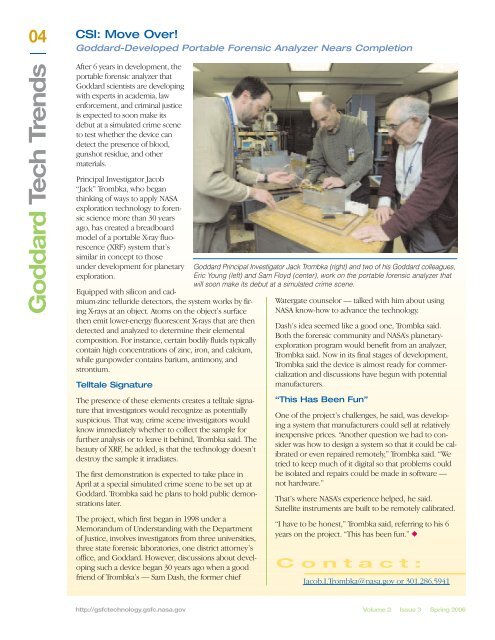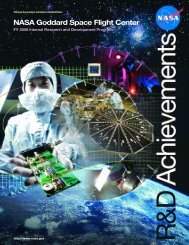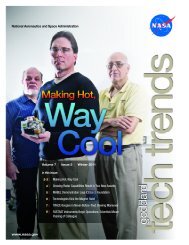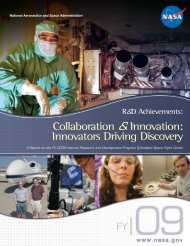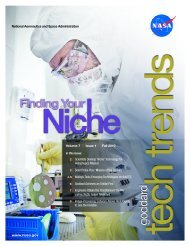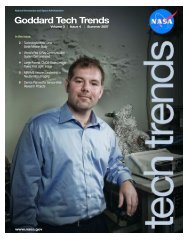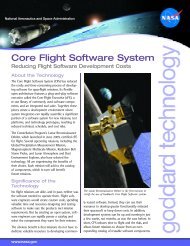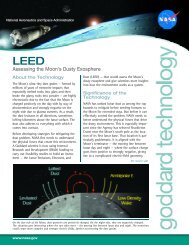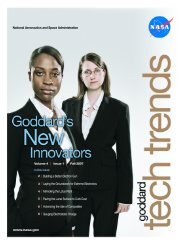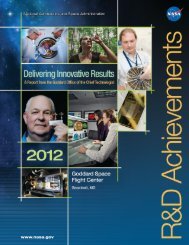Goddard Tech Trends - NASA's Goddard Technology Management ...
Goddard Tech Trends - NASA's Goddard Technology Management ...
Goddard Tech Trends - NASA's Goddard Technology Management ...
Create successful ePaper yourself
Turn your PDF publications into a flip-book with our unique Google optimized e-Paper software.
04<br />
CSI: Move Over!<br />
<strong>Goddard</strong>-Developed Portable Forensic Analyzer Nears Completion<br />
<strong>Goddard</strong> <strong>Tech</strong> <strong>Trends</strong><br />
After 6 years in development, the<br />
portable forensic analyzer that<br />
<strong>Goddard</strong> scientists are developing<br />
with experts in academia, law<br />
enforcement, and criminal justice<br />
is expected to soon make its<br />
debut at a simulated crime scene<br />
to test whether the device can<br />
detect the presence of blood,<br />
gunshot residue, and other<br />
materials.<br />
Principal Investigator Jacob<br />
“Jack” Trombka, who began<br />
thinking of ways to apply NASA<br />
exploration technology to forensic<br />
science more than 30 years<br />
ago, has created a breadboard<br />
model of a portable X-ray fluorescence<br />
(XRF) system that’s<br />
similar in concept to those<br />
under development for planetary<br />
exploration.<br />
Equipped with silicon and cadmium-zinc<br />
telluride detectors, the system works by firing<br />
X-rays at an object. Atoms on the object’s surface<br />
then emit lower-energy fluorescent X-rays that are then<br />
detected and analyzed to determine their elemental<br />
composition. For instance, certain bodily fluids typically<br />
contain high concentrations of zinc, iron, and calcium,<br />
while gunpowder contains barium, antimony, and<br />
strontium.<br />
Telltale Signature<br />
The presence of these elements creates a telltale signature<br />
that investigators would recognize as potentially<br />
suspicious. That way, crime scene investigators would<br />
know immediately whether to collect the sample for<br />
further analysis or to leave it behind, Trombka said. The<br />
beauty of XRF, he added, is that the technology doesn’t<br />
destroy the sample it irradiates.<br />
The first demonstration is expected to take place in<br />
April at a special simulated crime scene to be set up at<br />
<strong>Goddard</strong>. Trombka said he plans to hold public demonstrations<br />
later.<br />
The project, which first began in 1998 under a<br />
Memorandum of Understanding with the Department<br />
of Justice, involves investigators from three universities,<br />
three state forensic laboratories, one district attorney’s<br />
office, and <strong>Goddard</strong>. However, discussions about developing<br />
such a device began 30 years ago when a good<br />
friend of Trombka’s — Sam Dash, the former chief<br />
<strong>Goddard</strong> Principal Investigator Jack Trombka (right) and two of his <strong>Goddard</strong> colleagues,<br />
Eric Young (left) and Sam Floyd (center), work on the portable forensic analyzer that<br />
will soon make its debut at a simulated crime scene.<br />
Watergate counselor — talked with him about using<br />
NASA know-how to advance the technology.<br />
Dash’s idea seemed like a good one, Trombka said.<br />
Both the forensic community and NASA’s planetaryexploration<br />
program would benefit from an analyzer,<br />
Trombka said. Now in its final stages of development,<br />
Trombka said the device is almost ready for commercialization<br />
and discussions have begun with potential<br />
manufacturers.<br />
“This Has Been Fun”<br />
One of the project’s challenges, he said, was developing<br />
a system that manufacturers could sell at relatively<br />
inexpensive prices. “Another question we had to consider<br />
was how to design a system so that it could be calibrated<br />
or even repaired remotely,” Trombka said. “We<br />
tried to keep much of it digital so that problems could<br />
be isolated and repairs could be made in software —<br />
not hardware.”<br />
That’s where NASA’s experience helped, he said.<br />
Satellite instruments are built to be remotely calibrated.<br />
“I have to be honest,” Trombka said, referring to his 6<br />
years on the project. “This has been fun.” ◆<br />
Contact:<br />
Jacob.I.Trombka@nasa.gov or 301.286.5941<br />
http://gsfctechnology.gsfc.nasa.gov Volume 2 Issue 3 Spring 2006


